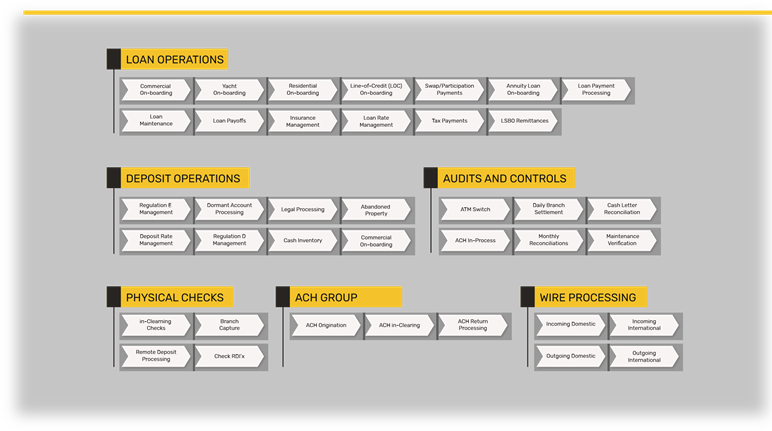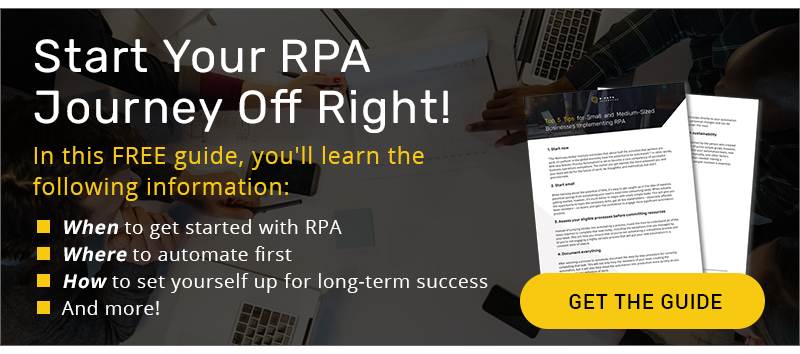Let’s say you’ve run a proof of concept project using Robotic Process Automation (RPA) and have validated its potential for your business. Nice work! You’re primed to begin your automation journey. So, what comes next?
To ensure long-term success, you need to build a backlog of automation projects and begin prioritizing them in alignment with your organization’s goals. Said another way, you need an automation roadmap. Establishing a roadmap – and remaining faithful to it – will help you to build momentum and reap all the benefits your RPA automation program has to offer.
Why Is It Important to Have a RPA Roadmap?
A well-defined automation roadmap will provide you with several benefits, including the following:
- Provide stakeholders with visibility into your progress.
- Capture your team’s current and future commitments.
- Ensure upcoming projects remain aligned with the business’s strategy.
- Create a framework to forecast and communicate the long-term benefits of automation.
The cornerstone of any automation roadmap is a project backlog. A backlog keeps your team fully engaged with a steady flow of work and helps everyone develop vision for how the RPA program will develop in the weeks and months ahead. But what’s the most effective way to build that backlog?
How to Build a Backlog for Your Automation Roadmap
Step 1: Identify a Starting Point
To build a backlog for your automation program, first identify which part of your organization you want to improve with RPA. Most organizations begin with groups that have numerous automation-ready tasks, such as those commonly found in operations, HR, or finance departments.
Step 2: Create a Value Chain Map
Next, you should create a value chain map for your selected team or department. A value chain map is essentially an organizational chart of the core processes in a particular working group.
For example, let’s say you’ve chosen to begin automating your finance department’s work. You’ll build a value chain map to capture all the finance processes at a high level, including budgeting and forecasting, reporting, payroll, accounts payable, etc. Each of these is then detailed in a process map to provide an overview of how work flows through the department. Individual process maps can be further disaggregated into subprocess maps to capture step-by-step tasks, the roles that perform those tasks, and the systems that are used, thereby providing a detailed picture for this area of your business.
To create a value chain map, follow these steps:
- Create a diagram or visual representation of the processes that drive the selected area of your business.
- Arrange these processes in a way that makes sense, such as by function, deliverable, or responsible team.
- Organize the diagram such that the areas of focus for your automation program are in the center; other processes can be added elsewhere to keep the target areas in context.
- Evaluate each process and document its cost, quality, importance, and variability.
The sample value chain map below applies to a bank’s operations, but you can imagine a similar map for your business. While not shown, this particular map drills deeper into each process to outline the step-by-step tasks, roles, and systems that make up each process.

Creating a value chain map requires time and collaboration, but the final product is extremely valuable. Often, the people doing the work have a very different view of the “as-is” process than the management team, so putting in the work to understand your processes up front will help ensure successful automations later.
Step 3: Identify Which Processes Should Be Prioritized
Now that you fully understand your processes and the value they deliver, you can evaluate the potential impact of automation on each one. To do so, ask yourself questions like:
- Where are the most people involved?
- Which processes will be most impacted by business growth?
- Which ones have the greatest cost or the most quality issues?
- Which processes are most important to our organization today? Which ones are going to be most important in the future?
- Which of these are highly variable and/or cause the most problems? Do the problems manifest on a regular cadence (e.g., weekly, monthly, etc.) or just occasionally?
- Which processes would cause an immediate emergency if they stopped for a day? Which are support activities that would not interrupt operations if they suddenly stopped?
The answers to these questions will help you determine which processes should be automated and how to best prioritize them. Obviously, you’ll focus on the project with the greatest potential impact on your organizational priorities first and then move to the next.
In case you missed it, you just created your automation roadmap and backlog of projects! Of course, the roadmap can and should evolve along with your business goals and priorities. It’s a good practice to revisit the prioritization quarterly (or on whatever cycle your organization sets new goals or objectives).
Step 4: Repeat This Exercise Across Your Organization
As you experience the positive effects of RPA, you will want to apply this approach for other functional areas in your organization. You just identify the next focus area, document the value chain, identify the processes that can benefit from automation, and prioritize them according to the potential return.
Ready to Embark On the Path to Automation?
At R-Path Automation, we leverage our decades of experience and expertise to help businesses like yours effectively implement automation. Working with the experts in RPA will set you up for success in your automation journey and drive real value for your organization – fast! Contact us today to get started.

